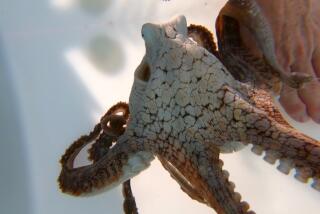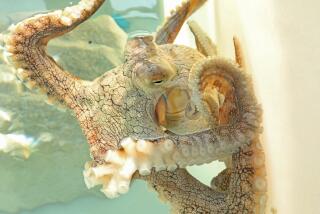Opossums’ Fate May Be Sealed Today
The fate of Orange County’s opossums, which county workers have been killing because the animals can carry a potentially fatal virus, may be decided today at a meeting of several agencies.
The killing of more than 3,600 opossums in 1986 and several hundred more during the first three months of this year, with only an occasional one being tested for the disease known as Murine typhus, angered the Opossum Society of California, based in the city of Orange, and veterinarian Anita Henness.
In April, Henness and the society, which she founded last year, protested the mandatory killing of opossums by county personnel, saying the animals were beneficial to humans because they destroy rats and many kinds of insects and clean up carrion.
In response to the protests, county authorities agreed that, starting in April and ending June 30, every opossum brought in by animal control officers still would be killed but all would be tested for Murine typhus, which is transmitted by fleas carried by opossums and some other animals, including cats. The reason for the extensive testing would be to “clear” the opossums from blame, Henness indicated.
County veterinarian Nila Kelly said the results from the three-month test “are being evaluated” and will be announced at today’s meeting.
The killing of opossums was ordered in early 1985 by the county Vector Control District, according to Dr. Thomas J. Prendergast, county epidemiologist, after an El Toro man contracted Murine typhus and an opossum, captured in the vicinity, tested positive as a source of the disease.
The man recovered, but vector control officers said that, because human lives could be at stake, the killing of every opossum caught was the safest course. However, the disease is considered “mild and treatable,” Prendergast said, with no fatalities in the state since 1976 and 20 during the 50 years before that.
Vector Control Director Gilbert L. Challet said the county “is going through a very high population explosion of opossums, higher then ever before,” and killing them “is our only control now.”
He added that animal control officers “do not go out hunting for possums. They only respond to calls from citizens who have trapped or penned up what they consider a nuisance.”
Opossums, he added, do not kill rats, as Henness claimed, although they do kill many objectionable insects and garden pests such as snails.
Pat Moore, spokesman for the state Department of Fish and Game, agreed with Challet that the opossum population is growing and that they are appearing more often in populated areas because of a scarcity of rain over the last two seasons.
Henness and her society have said that education of the public in dealing with wild creatures such as opossums should have top priority, even above relocating of the animals.
Relocation is frowned upon by the Department of Fish and Game “because putting them someplace else would just mess up the populations of other animals already there,” Moore said.
Among agencies to be represented at today’s meeting are Animal Control, Vector Control, Fish and Game and county Health Services.
More to Read
Sign up for Essential California
The most important California stories and recommendations in your inbox every morning.
You may occasionally receive promotional content from the Los Angeles Times.










